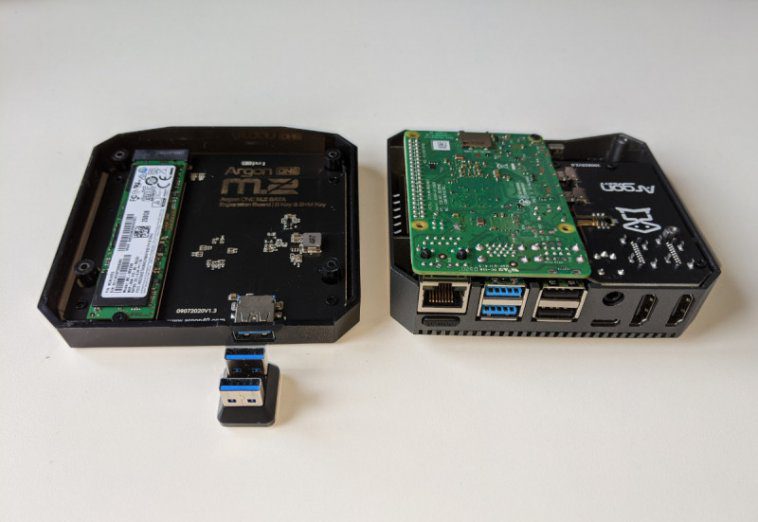The marquee addition here is support for an M.2 SATA SSD drive (the blade drives
commonly found in laptops). This sits snugly in a bottom compartment and is
connected to Raspberry Pi using the USB 3.0 connection (via a U-shaped adapter). It features UASP (USB Attached SCSI Protocol) support to increase performance.
In the spirit on things, we tested it with a Raspberry Pi 4 8GB RAM and Raspberry Pi
OS (64-bit) still in beta testing. An internal board repositions the ports to the rear, and converts the micro HDMI
ports of Raspberry Pi 4 to two full-sized HDMI sockets. GPIO remains accessible via
a removable flap with a pin guide printed to the side. The aluminium alloy lid acts as a heatsink and a 30mm fan provides active cooling.
The fan is controlled via a script provided by Argon 40. Default settings start at 10%
power when the CPU temperature is at 55ºC, increasing to 55% at 60ºC and 100%
at 65ºC.
Putting it together
Your M.2 SATA SSD clips into the lower part of the case and is held in place with a
single screw. The two halves are then screwed together and a U-shaped USB
adapter is used to bridge the lower part of the case the port on the upper part.
It’s an ingenious solution, but you lose a USB 3.0 socket in the final build. More
importantly, the microSD card socket is sealed inside the case, requiring
disassembly to access it.
Raspberry Pi EEPROM recently provided USB boot support in the default ‘critical’
firmware, and a recent update (still currently in beta but due soon) improves USB
boot performance. Once booted into Raspberry Pi OS, we installed Imager and used that to flash a
clean install of Raspberry Pi OS (64-bit) onto the SSD drive. Remove the USB thumb
drive and Raspberry Pi boots straight from the SSD.
Benchmarking the Argon M.2
We used a Samsung 850 EVO supplied by our friends at Custom PC magazine and installed Gnome Disks for its benchmarking test. The M.2 did not disappoint, with an average read rate of 367.1MB/s compared to
45MB/s for our SD card. That’s an 800% speed increase. Overjoyed with our SSD throughput rate, we set about testing CPU speed and
thermal performance (the two are related as Raspberry Pi OS throttles performance
if the CPU temperature exceeds 80°C). We performed a similar test to the one Gareth Halfacree uses when thermal testing
Raspberry Pi boards. We ran stress-ng and glxgears for ten minutes while monitoring CPU speed and temperature recordings, followed by a
five-minute cool-down period. The Raspberry Pi under stress remained cool, maxing out at 53ºC – not even high
enough for the fan to kick in, with the passive case doing all the cooling. We took our
Raspberry Pi clock speed up to 1800MHz and, after leaving
Raspberry Pi to recover, ran the test again. This time the board got a little more
stressed, maxing out at 73ºC – enough for the Argon fan to kick in at 100% speed,
but below the critical 80ºC point where Raspberry Pi OS begins to throttle back the
CPU speed. So at all times you get unrestrained performance with an overclocked Raspberry Pi 4
coupled with an ultra-fast SSD storage solution. If that’s not nifty, we don’t know what
is.
We did also install Ubuntu, but we could not install the scripts for the fan in this case
(as it depends on GPIO Zero), so the fan was on permanently. Raspberry Pi OS remains our preferred operating system at any rate. We spent a delightful couple of days knocking together the scripts for testing in
Visual Studio Code and creating graphs of the results in LibreOffice, all while doing browser research and writing up the results. Our Argon ONE M.2 build remained a
joy to use throughout.
Verdict
10/10
If you want to take Raspberry Pi 4 performance as far as it can go, this is the way to
do it.

